
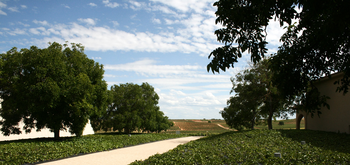 |
| In the 14th century, a chaplainry existed in the village of Pedrosa de Duero, nestled deep in the heart of the Ribera del Duero region of Spain. The inhabitants of the village donated small parcels of land to the chaplains in appreciation for the religious duties that they performed in the area. Over time, the chaplainry came to have a sizeable landholding. Some 500 years later, in 1855, the properties of the church and clergy were given over to the city council as part of the Ecclesiastical Confiscations of Mendizábal. Despite this, the inhabitants of Pedrosa continued to call the area “Pago de los Capellanes” in honor of the chaplains. Today, Pago de los Capellanes is one of the most prestigious wineries of the region. Located at around 800 meters high, the vineyards of Pago de los Capellanes only grow Tinto Fino (Tempranillo) grapes. The winery was initially founded with just a few select vines. It has expanded to a little more than 100 hectares of vineyards, planted using selection massale. Each plot receives personalized care, matching its unique features, to grow the best possible fruit. Harvest is limited to 5.000 kg of grapes per hectare - well below the 7.000 kg allowed by the Regulatory Council of Ribera del Duero. The vineyards are divided into 44 parcels, whose fruit is processed separately during vinification. In the months leading up to the harvest, samples from each parcel are taken daily, once in the morning and once in the afternoon. They are used to analyse the evolution of the grape clusters, and the degree of maturity of the berries. It is not until early October, when the grapes are at their finest, that harvest begins. The average daytime temperature at that time of year is 25C (77F). At night, it falls to 5C (41F). This high diurnal temperature variation aids the maturation of the fruit, and heightens the alcohol content, color and tannins, while helping to maintain good acidity and freshness. Total production is around 900,000 bottles. The winery was built around eight centuries-old walnut trees. The first phase was completed in 1996 - the year of the first vintage. An extension was added several years later to accommodate the winery’s current production capacity. The spectacular aging cellar, with exposed concrete arches, is ten meters underground. The whole project was completed in 2010. While decidedly bold and modern, it also respects and highlights the beauty of its environment, summing up the winery's ethos. Farming/vinification practices: sustainable. The vineyards are farmed organically in vintages that do not present too many difficulties. The wines are vegan. |
| Pago de los Capellanes Website |
 |
| Valdeorras Godello Sobre Lias "O Luar Do Sil" |
| 100% Godello, selected from two plots on granitic soil, near Codos de Larouco. The first vintage of this cuvée was 2014. The grapes are hand-harvested in the middle of September, using 15kg crates. They are destemmed, then undergo a cold maceration below 8ºC (46.5F) to obtain optimum aromas. They are then lightly pressed, and racked to remove the gross lees. The must is fermented in temperature-controlled stainless steel vats, using selected yeasts, for 14 days. After the fermentation, the wine is kept on the lees (sobre lìas) for 3 months, to gain richness, body and aromatic power, using bâtonage. It is then clarified naturally. Aromas of white and wild flower, green fruit, and intense minerality. On the palate, great balance between freshness and complexity. 13.5% alcohol. Pago de Los Capellanes is in the process of building a winery and purchasing more vineyards in Galicia. |
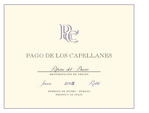 |
| Ribeira del Duero Joven |
| 100% Tempranillo from vines growing on a chalky clay soil, in Pedrosa de Duero. Harvest begins early October, and only the grapes with a high concentration of anthocyanins are selected. They are brought into the winery, and after a brief period of chilled pre-fermentation, alcoholic fermentation starts with indigenous yeasts. The wine is pumped over daily. At the end of the fermentation, the tanks are emptied and malolactic fermentation begins, without the addition of bacteria. The temperature is held steady at 20 ºC for a period of 24 days, during which the levels of malic and lactic acids are monitored. When the malic acid content is less than 0.1 grams per litre, the wine is racked off the lees and transferred to barrels. It is then aged for 5 months in medium toast, new French oak barrels. At the end of this period, it is put into tanks to rest, lightly filtered, then bottled. Intense floral and red forest fruit bouquet, with hints of vanilla. On the palate, full and velvety, elegant, with a lasting finish. 13.5% ABV. |
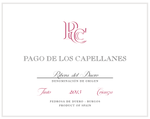 |
| Ribeira del Duero Crianza |
| 100% Tempranillo from vines growing on a chalky clay soil, in Pedrosa de Duero. Harvest begins early October, starting with the most mature parcels. They are brought into the winery, and after a brief period of chilled pre-fermentation, alcoholic fermentation starts with indigenous yeasts. The wine is pumped over daily. At the end of the fermentation, the tanks are emptied and malolactic fermentation begins, without the addition of bacteria. The temperature is held steady at 20 ºC for a period of 22 days, during which the levels of malic and lactic acids are monitored. When the malic acid content is less than 0.1 grams per litre, the wine is racked off the lees and transferred to barrels. It is then aged for 12 months in medium toast, new and semi-new (no older than 3 years) French oak barrels. At the end of this period, it is put into tanks to rest, lightly filtered, then bottled. Good balance of fruit and wood, with notes of vanilla intermingling with ripe black fruit/black berries. Hints of leather and liquorice, coming from both the oak barrels and the grape. On the palate, round with fine tannins, long finish. 13.5% ABV. |
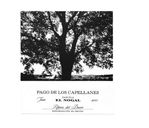 |
| El Nogal |
| 100% Tempranillo. The vines grow on a chalky clay soil, and come from El Nogal, a six-hectare parcel in Pedrosa de Duero. This parcel is monitored very carefully, and the decision to harvest is made separately from all the estate's other wines. After being brought to the winery, the grapes are subjected to a pre-fermentation cold maceration at 14ºC for 6 days, in order to achieve the greatest possible aromas. Later, the wine undergoes controlled alcoholic fermentation in a large French oak vat with indigenous yeasts, at 26ºC, for up to 28 days. At the end of the alcoholic fermentation, malolactic fermentation begins, without the addition of bacteria. The temperature is held steady at 20 ºC for a period of 22 days. The wine is then aged for 18 months in new French oak barrels. It is bottled without fining or filtration. Intense aromas of flowers and fresh fruits, giving way to notes of vanilla, cocoa and leather. Hints of sandalwood, spices, tobacco and liquorice. The attack is elegant, followed by power and complexity. Ripe fruit and round tannins. This is a serious wine, with a long life ahead. 14% ABV. |
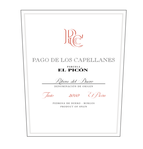 |
| El Picon |
| 100% Tempranillo. The vines grow on a chalky clay soil, and come from El Picon, a two-hectare parcel in Pedrosa de Duero. This parcel is monitored very carefully, and the decision to harvest is made separately from all the estate's other wines. The wine is fermented in a large French oak vat with indigenous yeasts, and pumped over frequently. At the end of the alcoholic fermentation, malolactic fermentation begins, without the addition of bacteria. The temperature is held steady at 22 ºC for a period of 24 days. The wine is then aged for 26 months in new French oak barrels selected for their grain, with decanting every six months (four times in total). It is bottled without fining or filtration. Balsamic notes on the nose, with aromas of berries and hints of spice (cinnamon), leather, tobacco, truffles & liquorice. On the palate, this is a complex wine, with sweet, round tannins and a persistent finish. This wine benefits from being decanted. 14.5% ABV. 3000 bottles produced. |
| Copyright © 2002-2017 VOS Selections, Inc. |